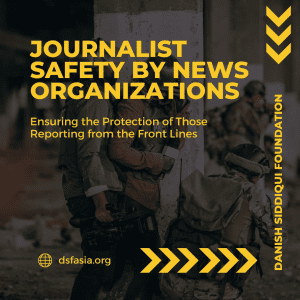Journalists have a vital role in society by informing the public about events and issues affecting their lives. However, the nature of their work can also expose them to a range of safety threats, mainly when reporting from conflict zones, disaster areas, or covering crime and political unrest. Journalist safety training is designed to help journalists prepare for and respond to these threats to ensure their safety while on assignment.
The Need for Journalist Safety Training
Journalists must often work in high-risk environments where they face physical threats such as violence, kidnapping, or exposure to hazardous materials. Additionally, they may be targeted by cyber threats, which can compromise their data and communications. In such situations, journalists need to be well-prepared and equipped to manage risks to their safety as well as the safety of their colleagues.
Journalist safety training can help journalists prepare for such situations by teaching them to assess risks, identify potential threats, and develop strategies to minimize or avoid them. This training can also equip journalists with the necessary skills to manage stress and trauma related to their work and to seek help when needed.
Elements of Journalist Safety Training
Journalist safety training may cover a wide range of topics, depending on the specific needs of the journalists and the nature of their work. Some common elements of journalist safety training include:
- Risk assessment: One of the essential elements of journalist safety training is learning to assess risks. This involves identifying potential threats and developing strategies to minimize or avoid them. This may include learning how to conduct a security assessment of an area, assessing the credibility of sources, and identifying potential risks associated with particular assignments.
- Situational awareness: Journalists need to be aware of their surroundings at all times and able to identify potential threats. Situational awareness training can help journalists stay alert and identify potential dangers, such as unmarked landmines or violent crowds.
- First aid and medical training: Journalists in high-risk environments may encounter injuries or illnesses. Therefore, they need basic first aid skills and more specialized training in dealing with injuries and diseases that may occur in the field.
- Security protocols: Journalist safety training may also teach journalists how to use security measures to protect themselves and their colleagues. This may include training on using protective gear, maintaining communication with colleagues and authorities, and establishing secure work environments.
- Digital security: Journalists also face cyber threats like hacking or surveillance. Therefore, journalist safety training may also include training on digital security, including protecting sensitive information and communications and identifying and responding to cyber threats.
- Psychological support: Journalists may be exposed to traumatic events. As such, journalist safety training may also include training on managing stress and trauma related to their work and seeking help when needed.
Benefits of Journalist Safety Training
Journalist safety training offer several benefits to journalists and news organizations, including:
- Improved safety: The most apparent benefit of journalist safety training is that it can help keep journalists safe while on assignment. This is particularly important in high-risk environments where journalists may be exposed to violence, disease, or other hazards.
- Enhanced reporting: When journalists feel safe, they are more likely to produce better and more accurate reporting. Journalist safety training can help journalists feel more confident and prepared, leading to improved reporting.
- Reduced liability: News organizations that provide journalist safety training may be less liable for accidents or injuries during assignments, as they have taken steps to ensure their journalists are well-prepared and equipped to manage risks.
- Improved morale: Journalist safety training can also have a positive impact on the morale of journalists. Knowing that their news organization is invested in their safety can help journalists feel valued and supported, leading to higher job satisfaction and lower turnover rates.
- Reputation: Journalist safety training can also improve the reputation of news organizations. News organizations can build trust with their audiences and stakeholders by demonstrating a commitment to journalist safety.
- Networking: Journalist safety training can also provide opportunities for journalists to network and connect with other professionals in their field. This can help them build relationships, share best practices, and learn about new developments in journalist safety.
Types of Journalist Safety Training
Journalist safety training can take many different forms, depending on the needs of the journalists and the nature of their work. Some common types of journalist safety training include:
- In-person training: Traditional in-person training in a classroom or the field. In-person training can be more hands-on and immersive, providing journalists real-world experience and feedback.
- Online training: Online training can be accessed from anywhere and at any time, making it a convenient option for journalists with busy schedules or working in remote locations. Online training may also be less expensive than in-person training.
- Workshops and seminars: Workshops and seminars can be a more intensive form of training, allowing journalists to work closely with experts in their field. This training may be geared towards a specific topic, such as digital security or first aid.
- Field exercises: Involve simulating real-world scenarios to help journalists practice their skills and test their preparedness. Field exercises can be valuable training, as they provide journalists with hands-on experience in a safe and controlled environment.
Several organizations provide journalist safety training, including:
- Committee to Protect Journalists (CPJ) – CPJ is an independent, nonprofit organization that promotes press freedom worldwide and provides safety training for journalists.
- Reporters Without Borders (RSF) – RSF is an international nonprofit organization that advocates for press freedom and provides training for journalists on safety issues.
- International News Safety Institute (INSI) – INSI is a nonprofit organization that provides safety training and resources for journalists, including online courses and safety guides.
- Rory Peck Trust – The Rory Peck Trust is a UK-based nonprofit organization that provides safety training and support to freelance journalists and their families.
- Dart Center for Journalism and Trauma – The Dart Center is a global network of journalists, journalism educators, and health professionals dedicated to improving media coverage of trauma, conflict, and tragedy. They provide training and resources to help journalists manage the emotional toll of covering difficult stories.
- International Center for Journalists (ICFJ) – ICFJ is a nonprofit organization that provides training and support to journalists worldwide, including safety training and resources.
- Free Press Unlimited – Free Press Unlimited is a nonprofit organization based in the Netherlands that supports independent journalism in countries where press freedom is under threat. They provide safety training and resources for journalists, including digital security training.
These are just a few examples of organizations that provide journalist safety training. Many other organizations, both local and international, offer similar services.
To conclude, journalist safety training is essential to ensuring journalists’ safety while on assignment. By providing journalists with the skills and knowledge they need to manage risks and stay safe, journalist safety training can help protect journalists and enhance the quality of their reporting. News organizations that invest in journalist safety training demonstrate a commitment to their journalists’ safety and well-being, which can positively impact their reputation, morale, and bottom line. As the risks facing journalists continue to evolve, journalist safety training will remain critical for keeping journalists safe and ensuring the free flow of information in our society.




